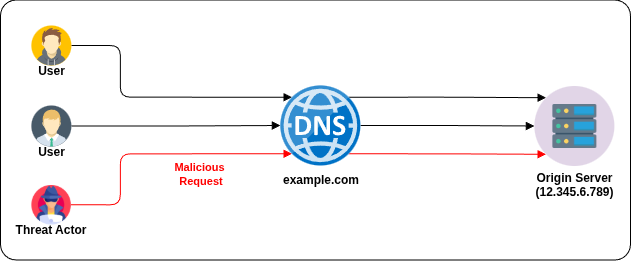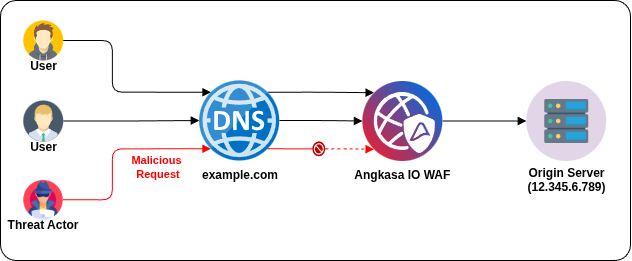How AngkasaIO WAF Works
Process in the backgound
When a user types a URL into a browser (e.g. https://example.com/) and presses Enter, the browser first looks up the website’s IP address using DNS (Domain Name System) (e.g. 12.345.6.789). Once it finds the IP, it connects to the web server using HTTP or HTTPS and sends a request for the webpage. The server processes this request, retrieves the necessary files (HTML, CSS, JavaScript, images), and sends them back to the browser. The browser then renders the page by displaying the content and executing scripts. If the page has additional elements, like videos or data from a database, the browser may send more requests to fully load everything.
Without AngkasaIO WAF

When a server request is made without a Web Application Firewall (WAF) Protection, the request goes directly to the web server, meaning the server must handle all traffic, including malicious requests, bot attacks, and DDoS floods. This exposes the server to security threats such as SQL injection, cross-site scripting (XSS), and brute-force attacks, which can lead to data breaches, downtime, or poor performance.
With AngkasaIO WAF

When a server request is made with a AIOWAF Protection is enabled, it acts as a protective shield that filters and analyzes incoming requests before they reach the server. It blocks malicious traffic, prevents attacks, and optimizes performance by reducing unnecessary load on the server. Additionally, a WAF can enhance website speed and reliability by caching content, balancing traffic, and preventing overloading. Essentially, a WAF provides an extra layer of security and efficiency, ensuring only safe and legitimate requests reach your server while keeping cyber threats at bay.
Benefits
Using a AngkasaIO Web Application Firewall (AIOWAF) provides numerous security, performance, and operational benefits. Here’s why businesses and organizations should implement a WAF proxy:
Security Benefits
- Protection Against Cyber Threats A WAF proxy blocks common web-based attacks, including:
- SQL Injection (SQLi) – Prevents database manipulation.
- Cross-Site Scripting (XSS) – Stops malicious scripts from running in users' browsers.
- Cross-Site Request Forgery (CSRF) – Blocks unauthorized actions on user accounts.
- Remote Code Execution (RCE) – Prevents attackers from executing malicious code on your server.
- DDoS Mitigation A WAF proxy helps absorb and filter Distributed Denial-of-Service (DDoS) attacks, ensuring your application remains online. It limits excessive requests from malicious IPs and botnets.
- Zero-Day Attack Prevention Uses machine learning & threat intelligence to detect and block unknown vulnerabilities before they are exploited.
- OWASP Top 10 Protection A WAF proxy safeguards against the most critical web vulnerabilities outlined in the OWASP Top 10 security risks.
Performance Benefits
- Load Balancing Distributes traffic across multiple origin servers, improving server efficiency and reducing downtime.
- Content Caching Caches static assets (e.g., images, CSS, JavaScript) at the WAF level to reduce the load on the origin server and improve page load speed.
- SSL/TLS Termination Offloads SSL decryption from the origin server, reducing CPU usage and improving overall performance.
- Edge Optimization Reduces latency by serving cached or optimized content closer to users via edge locations.
Operational Benefits
- Centralized Security Management Allows security policies to be configured once and applied across multiple web applications and APIs.
- Compliance and Regulations Helps businesses meet security standards such as: GDPR (General Data Protection Regulation) PCI-DSS (Payment Card Industry Data Security Standard) HIPAA (Health Insurance Portability and Accountability Act)
- Traffic Monitoring & Logging Provides detailed analytics on web traffic, attack attempts, and security trends. Enables real-time alerts for suspicious activities.
